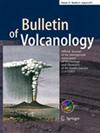历史记载为20世纪希腊圣托里尼火山喷发的地质演化提供了洞见
IF 3.2
2区 地球科学
Q1 GEOSCIENCES, MULTIDISCIPLINARY
引用次数: 0
摘要
20世纪希腊圣托里尼火山的喷发是这座火山漫长的生命周期中最近的一次活动。虽然传统上认为1925年至1950年间发生的不同喷发表现出相似的喷发风格,但它们的演化方面和与个别喷发动力学有关的精确信息却很少得到约束。本研究整理了主要来自希腊国家科学委员会的实地报告和历史记录,该委员会被指派通过最近的实地活动研究Nea Kameni岛的火山活动。这一分析提供了对这些喷发的进一步了解,并试图解开爆发和喷涌事件发生的时间和风格。对近期地质演化和喷发历史的重建,可以更完整地描述喷发动力学和相关的动荡。这些特征包括火山喷发行为、爆炸强度、熔岩流的方向和体积、喷发持续时间、火山口形态变化(如陨石坑、圆顶和马蹄形堡垒)、结构特征和熔岩形态,以及地表破裂。与火山爆发和相关产物的第一手资料相关的具体特征,结合我们在现场进行的火山爆发后地质研究,可以更好地重建火山爆发之前和期间的活动,这有助于了解火山爆发的发展,并根据前兆活动的模式增强对未来潜在火山爆发的预测。本文章由计算机程序翻译,如有差异,请以英文原文为准。

Historical accounts provide insight on the geological evolution of the 20th century eruptions at Santorini volcano, Greece
Abstract The 20th century eruptions of the Santorini volcano in Greece are the most recent activity of the volcano’s long lifespan. While the different eruptions taking place between 1925 and 1950 have traditionally been considered to exhibit similar eruptive styles, aspects of their evolution and precise information related to the individual eruption dynamics were poorly constrained. This study collates field reports and historical accounts, mainly from the Greek national scientific committee, which was assigned to study the volcanic activity in Nea Kameni Island with recent field campaigns. This analysis provides further insight into these eruptions and attempts to unravel the timing and style of explosive and effusive episodes that took place. Reconstruction of the recent geological evolution and of the eruptive history allow a more complete description of the eruption dynamics and associated unrest. These include fumarolic behaviour, explosion intensity, direction and volume of the lava flows, eruption duration, vent morphological changes (such as craters, domes, and horseshoe ramparts), textural characteristics and lava morphologies, as well as surface fracturing. Specific features related to first-hand accounts of the eruptions and associated products, in conjunction with our in situ post-eruptive geological study, allow an improved reconstruction of activity, both prior to and during the historical eruptions, which contributes to understanding the development of the eruption and enhances the forecast of potential future eruptions from patterns of precursory activity.
求助全文
通过发布文献求助,成功后即可免费获取论文全文。
去求助
来源期刊

Bulletin of Volcanology
地学-地球科学综合
CiteScore
6.40
自引率
20.00%
发文量
89
审稿时长
4-8 weeks
期刊介绍:
Bulletin of Volcanology was founded in 1922, as Bulletin Volcanologique, and is the official journal of the International Association of Volcanology and Chemistry of the Earth’s Interior (IAVCEI). The Bulletin of Volcanology publishes papers on volcanoes, their products, their eruptive behavior, and their hazards. Papers aimed at understanding the deeper structure of volcanoes, and the evolution of magmatic systems using geochemical, petrological, and geophysical techniques are also published. Material is published in four sections: Review Articles; Research Articles; Short Scientific Communications; and a Forum that provides for discussion of controversial issues and for comment and reply on previously published Articles and Communications.
 求助内容:
求助内容: 应助结果提醒方式:
应助结果提醒方式:


